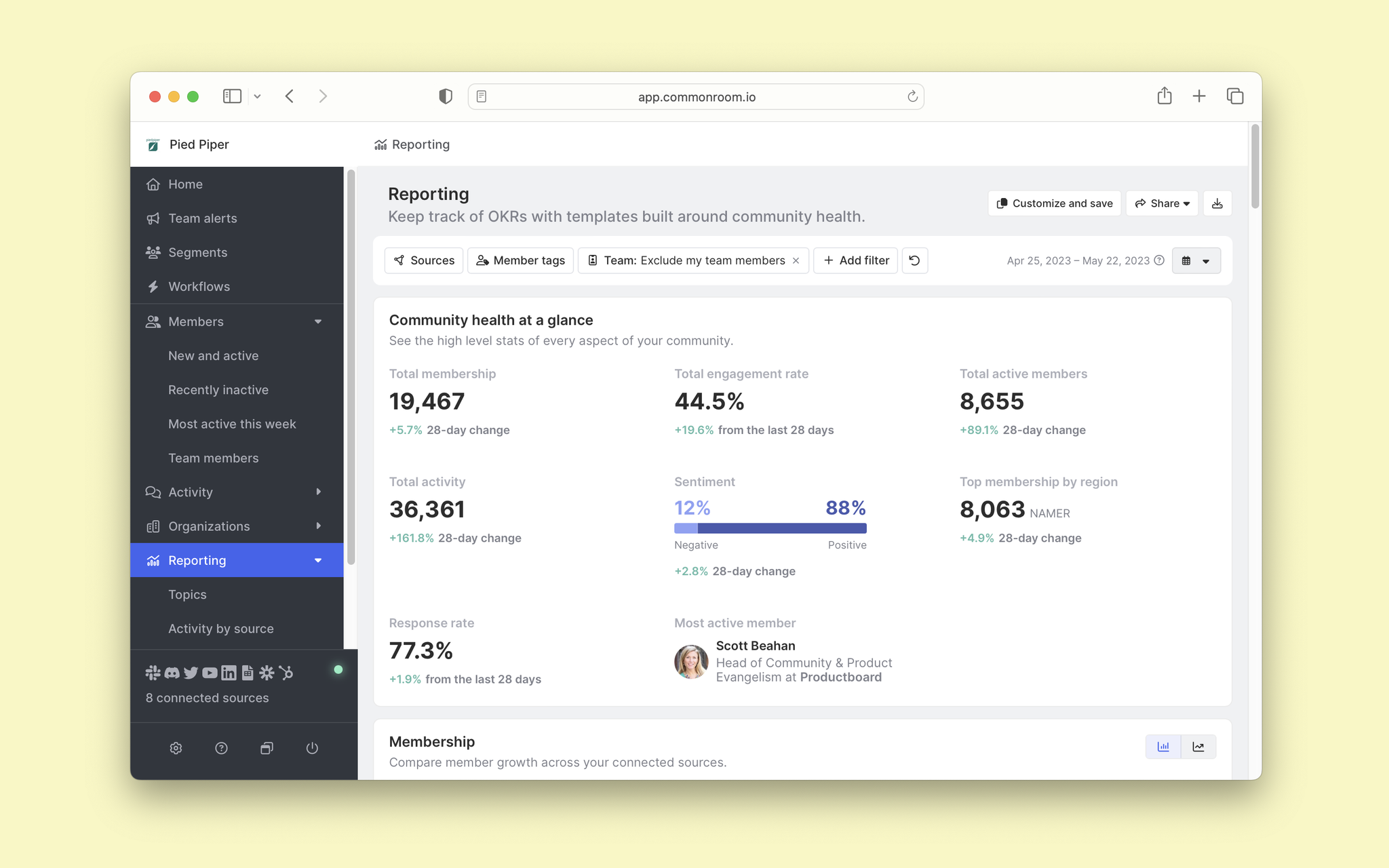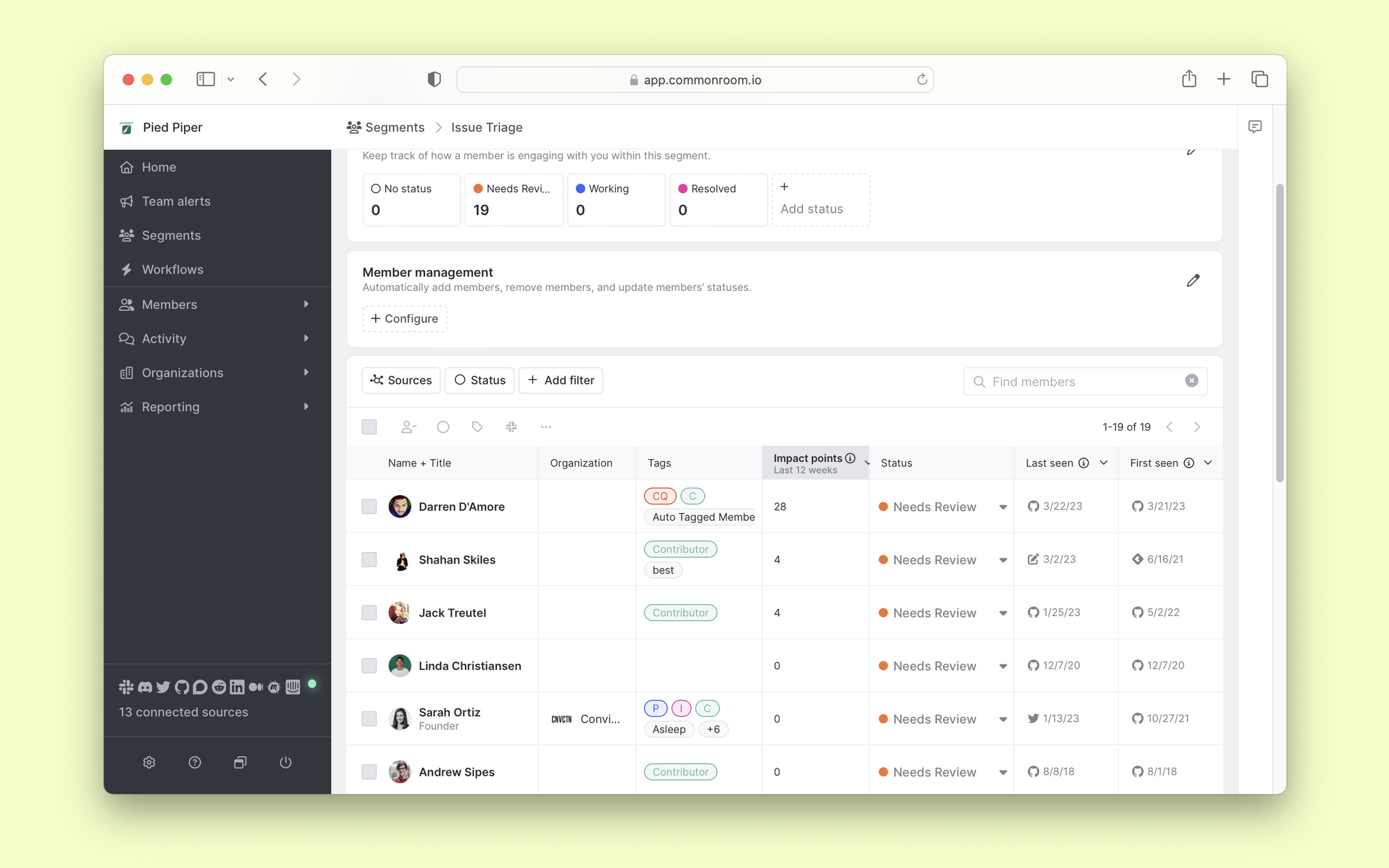Serving your community members and serving your business goals aren’t mutually exclusive. In fact, they’re intrinsically linked: Providing value to your community is key to driving business results.
But that doesn’t mean it’s always easy. It requires employing the right tactics, using the right tools, and finding the right balance between your priorities.
Common Room’s Head of Community Rebecca Marshburn and Common Room Account Executive Claire Kennedy discussed that and much more with Tyler Hannan, Senior Director of Developer Advocacy at ClickHouse, in our recent event: How ClickHouse uses Common Room to engage its community and drive impact for GTM teams.
Here are three of the top takeaways from that conversation, including:
- Which community metrics should be top of mind
- How to get more granular while staying scalable
- Why community and sales professionals make perfect partners
1. Helpful communities are healthy communities
When you’re measuring the success of your community, it’s easy to get laser-focused on growth—that is, how many members you have and how quickly that number rises.
But engagement is the lifeblood of any community, particularly when it comes to how often and how quickly community members respond to each other. Your internal team plays a crucial role, but data shows that community members are more likely to respond to each other than your team (28% versus 13%).
So if you sell a technical open-source product, community engagement is how questions get answered, problems get solved, and value is created for your members.
“Fundamentally, a healthy community is a community that answers each other's questions,” Tyler said.
That’s why the team at ClickHouse prioritizes response rate as its No. 1 metric—and why it uses Common Room to track it. It wants to know whether its community members are receiving the answers they need, either in its owned Slack community or across unowned channels, such as GitHub, Stack Overflow, and YouTube.
By centralizing all community data in a single place, team members can quickly get a bird’s eye view of responses without having to log in and out of various platforms and manually pore over business-relevant activity.
“It was never something I was able to quantify simply until turning on Common Room,” Tyler said. “And then I was like, ‘Oh, this is what I've been looking for the last decade.’”
Reporting in Common Room also makes it easy for ClickHouse to keep tabs on time to response across all connected channels.

This is hugely valuable in an economic climate where teams are being asked to do more with less.
“Prior to current economic conditions […] one of the ways to address this when it felt like you weren't answering questions was to just hire more humans to throw at the problem,” Tyler said. “That's not a thing we do anymore, sort of broadly as an industry.”
2. Communities come in many forms (and live on many channels)
Communities come together around shared interests and goals, whether they’re communities of practice or communities of product. But they’re also made up of unique individuals—people who live in different regions, have different job responsibilities, and face different challenges.
“I just had the opportunity to spend a week in India,” Tyler said. “The community in India is fundamentally different from the community in EMEA, which is very, very different from the community in North America. And that's a feature, not a bug, but it's important that I begin to look at those regions and their growth individually.”
One way the team at ClickHouse does this is by using segments in Common Room. Segments allow the team to create cohorts to manage programs and track status updates specific to certain groups of community members.
For example, while in India, Tyler decided ClickHouse should hold a community meetup in Bangalore. So he used Common Room to filter for community members based near that location, add them to a segment, and bulk message them.
“It becomes a way for me to leverage the information that we have about the community to do outreach for these hyper-local meetups that we're running,” Tyler said.

But meeting community members where they are goes beyond geographic location—it also means paying attention to the digital watering holes they prefer. Sometimes community teams believe they can launch a Discourse or GitHub Discussions forum and that the people they want to reach will automatically flock to it, but that’s not the case.
“I think the sort of fundamental shift we've seen over the last two years probably, and the reason why Common Room is so important, is I need to go where my users are,” Tyler said. “I don't need to demand that they come to me.”
Since Common Room has dozens of integrations with different channels, it acts as a bridge between them for the ClickHouse team. The team can engage community members on their channels of choice without creating platform silos or losing visibility into the customer journey.
“Our platform becomes centralized through Common Room,” Tyler said.
3. Community and sales teams work better together
Community and sales teams are sometimes viewed as rivals with competing priorities.
“I have been at companies where it became us versus them—community versus sales, community versus marketing,” Tyler said. “That's a common thing that, unfortunately, I think those of us who are DevRel or community practitioners run into a lot.”
Part of the problem stems from how these teams measure their success. Community teams are generally more focused on membership growth, engagement, and other metrics related to building awareness and trust. Meanwhile, sales teams are typically more focused on booking meetings and closing deals.
But both teams should be focused on providing a better customer experience. That requires understanding how each team can contribute to the customer journey, as well as how each team can help the other reach its desired outcomes.
“When I think about alignment, I think about alignment less about OKRs or what I’m measuring this month and more about why community exists,” Tyler said.
At ClickHouse, it exists to build product awareness, empower product users, and fuel product adoption in an authentic, trustworthy way that helps the company win deals.
“I'm very lucky that at ClickHouse we have the fundamental alignment on strategy, which is that more people need to hear our story and more people need to use ClickHouse,” Tyler said. “And as more people do that, we have the opportunity to grow the business.”
Some companies feel strongly that community and sales should stay siloed, but ClickHouse takes a different tack.
“There are companies that are well-known for having a very firm line of separation,” Tyler said. “Community is here, sales is here, and never the twain shall meet. The twain should meet when it's respectful.”
Community professionals may worry that they’re trading on the trust and goodwill of members (or potentially ruining the community experience) by inviting sales colleagues into the fold, but there’s a big difference between treating your community as a lead list and working together to deliver value.
“When [our sales team is] running a training event or when they have an online course, I'm more than happy to share it with the community even though there is a call to action associated with it because there's value that's gained from it,” Tyler said.
The key is for community and sales teams to communicate openly, honestly, and respectfully about when and how it makes sense to work together. That makes it easier for team members to trust their colleagues to get involved.
As technologies enable more cross-channel insights, it’s imperative for different business functions to understand what it means for everyone to be a steward of the community—as well as who should take the lead depending on the channel or situation.
“If we're hosting a field marketing event [...], I should not be ashamed of saying, ‘Hey, here's the registration form,’” Tyler said. “I know that they're going to have to enter information. I know that that information is going to be entered into a CRM. I know that they're going to be reached out to with a nurture [campaign]. That's okay because I trust the outreach that sales is doing.”
At ClickHouse, the community team helps connect members to the sales team when it makes sense. It also provides key background information.

“It allows me to be able to be like, ‘Hey, that lead that just came in that we saw in Slack or came into the CRM, here's more context around it,’” Tyler said. “And over time we'll be able to automate that context that's coming out of Common Room directly because, again, as long as it's rooted in doing the right thing for the user, it's sort of the right thing for the company at that point.”
The role DevRel teams play in driving business impact has become a bigger conversation in today’s economic environment.
“For years I joked that DevRel was a travel agency that was measured in hugs and high fives, and then all of a sudden it was like, ‘And what's your revenue contribution?’” Tyler said.
This makes it all the more important to be able to measure the impact of community on bottom-line business metrics. In sales, the term “bluebird” is used to describe deals that seem to just fall out of the sky and close quickly. But oftentimes, those “bluebirds” aren’t due to luck—they’re community-sourced.
“The beauty of Common Room is when we win a deal, I can see where they are in the community, I can see where they've interacted,” Tyler said. “When a lead comes in, I'm able to hop in there. I'm able to look into their member record and be like, ‘Hey, you know what? They connected with us a year-and-a-half ago at a Meetup, and then they opened up a GitHub issue, and then they liked a whole bunch of stuff on LinkedIn."
This not only helps the ClickHouse team get a better picture of the customer journey over time, it also helps the team give their colleagues in sales a better view into where potential buyers are engaging with the company and why community work matters.
“Rather than becoming us versus them, to me, this ability to have a broader view of my community allows us to work toward a common goal,” Tyler said.
Full visibility into your community—and the ability to quickly take action on it—doesn’t just help you deliver more value to your community members. It also helps you maximize business impact.
Create and capture value with Common Room
Ready to see how Common Room helps you build better communities and drive business impact?